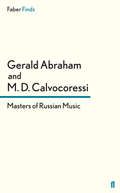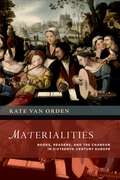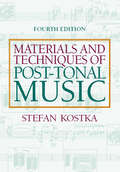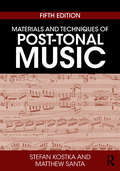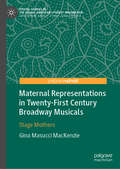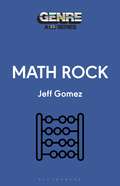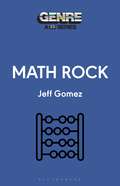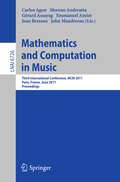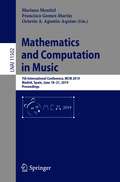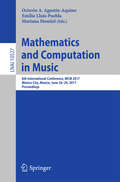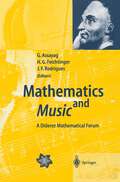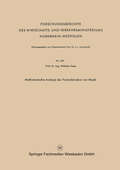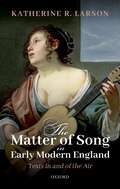- Table View
- List View
The Masters: Conversations with Dylan, Lennon, Jagger, Townshend, Garcia, Bono, and Springsteen
by Jann S. WennerFrom New York Times bestselling author and Rolling Stone founder comes "a visit to the Mount Olympus of rock" in this remarkable collection of new and collected interviews with some of the greatest rock stars and cultural icons of our time (Kirkus Reviews). During fifty years of publishing the &“Bible of Rock and Roll,&” Jann Wenner conducted a series of interviews that are now regarded among the most important historical documents of rock. Some of these conversations broke headlines—in 1970, his interview with John Lennon exposed the unvarnished tensions that led to the breakup of the Beatles. He gets up-close-and-personal with Bob Dylan, the most singular figure in music who revealed himself to Wenner more openly than to anyone else. And Mick Jagger only trusted one person to publicly interview him about his private life and his backstage account of the world's greatest rock band. Including stunning photographs and an exclusive, never-before-seen interview with Bruce Springsteen, The Masters intimately profiles the extraordinary musicians who dominated rock and roll, from London and California to New York and L.A.. This is a primary source, cultural masterpiece, and must-have volume about the artists who changed history.
Masters of Russian Music
by Doctor Gerald Abraham Peter CalvocoressiFirst published in 1936, Calvocoressi's and Abraham's study was the first complete account of its subject to appear in any language, including Russian, and was based on a large amount of original first-hand research. Over 75 years later Masters of Russian Music retains its power - as any study of Tchaikovsky, Mussorgsky, Rimsky-Korsakof, Scriabin, Borodin et al really ought to, since these were composers whose extraordinary musical accomplishments still left room in their lives for all manner of other interesting (and sometimes eccentric) activities. The portraits in this volume are scholarly, authoritative, and highly lively - as befitting the eminent talents under discussion.
Material Cultures of Music Notation: New Perspectives on Musical Inscription (Music and Material Culture)
by Floris SchuilingMaterial Cultures of Music Notation brings together a collection of essays that explore a fundamental question in the current landscape of musicology: how can writing and reading music be understood as concrete, material practices in a wider cultural context? Drawing on interdisciplinary approaches from musicology, media studies, performance studies, and more, the chapters in this volume offer a wide array of new perspectives that foreground the materiality of music notation. From digital scores to the transmission of manuscripts in the Middle Ages, the volume deliberately disrupts boundaries of discipline, historical period, genre, and tradition, by approaching notation's materiality through four key interrelated themes: knowledge, the body, social relations, and technology. Together, the chapters capture vital new work in an essential emerging area of scholarship.
Material Cultures of Music Notation: New Perspectives on Musical Inscription (Music and Material Culture)
by Floris Schuiling Emily PayneMaterial Cultures of Music Notation brings together a collection of essays that explore a fundamental question in the current landscape of musicology: how can writing and reading music be understood as concrete, material practices in a wider cultural context? Drawing on interdisciplinary approaches from musicology, media studies, performance studies, and more, the chapters in this volume offer a wide array of new perspectives that foreground the materiality of music notation. From digital scores to the transmission of manuscripts in the Middle Ages, the volume deliberately disrupts boundaries of discipline, historical period, genre, and tradition, by approaching notation's materiality through four key interrelated themes: knowledge, the body, social relations, and technology. Together, the chapters capture vital new work in an essential emerging area of scholarship.
Materialities: Books, Readers, and the Chanson in Sixteenth-Century Europe (New Cultural History of Music)
by Kate van OrdenEphemeral, fragile, often left unbound, sixteenth-century songbooks led fleeting lives in the pockets of singers and on the music desks of instrumentalists. Constantly in action, they were forever being used up, replaced, or abandoned as ways of reading changed. As such they document the acts of early musicians and the practices of everyday life at the unseen margins of elite society. Materialities is a cultural history of song on the page. It addresses a series of central questions concerning the audiences for written music by concentrating on the first genre to be commercialized by music printers: the French chanson. Scholars have long stressed that chansons represent the most broadly disseminated polyphony of the sixteenth century, but Materialities is the first book to account for the cultural reach of the chanson across a considerable cross-section of European society. Musicologist Kate van Orden brings extensive primary research and new analytical models to bear in this remarkable history of songbooks, music literacy, and social transformation during the first century of music printing. By tracking chansons into private libraries and schoolrooms and putting chansonniers into dialogue with catechisms, civility manuals, and chapbooks, Materialities charts the social distribution of songbooks, the gradual moralization of song, and the ways children learned their letters and notes. Its fresh conclusions revise several common assumptions about the value early moderns attributed to printed music, the levels of literacy required to perform polyphony, and the way musicians did or did not "read" their songbooks. With musical perspectives that can invigorate studies of print culture and the history of reading, Materialities is an essential guide for musicologists working with original sources and historians of the book interested in the vocal performances that operated alongside print.
MATERIALITIES NCHM C: Books, Readers, and the Chanson in Sixteenth-Century Europe (New Cultural History of Music)
by Kate van OrdenEphemeral, fragile, often left unbound, sixteenth-century songbooks led fleeting lives in the pockets of singers and on the music desks of instrumentalists. Constantly in action, they were forever being used up, replaced, or abandoned as ways of reading changed. As such they document the acts of early musicians and the practices of everyday life at the unseen margins of elite society. Materialities is a cultural history of song on the page. It addresses a series of central questions concerning the audiences for written music by concentrating on the first genre to be commercialized by music printers: the French chanson. Scholars have long stressed that chansons represent the most broadly disseminated polyphony of the sixteenth century, but Materialities is the first book to account for the cultural reach of the chanson across a considerable cross-section of European society. Musicologist Kate van Orden brings extensive primary research and new analytical models to bear in this remarkable history of songbooks, music literacy, and social transformation during the first century of music printing. By tracking chansons into private libraries and schoolrooms and putting chansonniers into dialogue with catechisms, civility manuals, and chapbooks, Materialities charts the social distribution of songbooks, the gradual moralization of song, and the ways children learned their letters and notes. Its fresh conclusions revise several common assumptions about the value early moderns attributed to printed music, the levels of literacy required to perform polyphony, and the way musicians did or did not "read" their songbooks. With musical perspectives that can invigorate studies of print culture and the history of reading, Materialities is an essential guide for musicologists working with original sources and historians of the book interested in the vocal performances that operated alongside print.
Materials and Techniques of Post Tonal Music
by Stefan KostkaThis text provides the most comprehensive analytical approach to post-tonal music available, from Impressionism to recent trends. It covers music from the early 1900s through the present day, with discussion of such movements as Minimalism and the Neoromanticism, and includes chapters on rhythm, form, electronic and computer music, and the roles of chance and choice in post-tonal music. Chapter-end exercises involve drills, analysis, composition, as well as several listening assignments.
Materials and Techniques of Post Tonal Music
by Stefan KostkaThis text provides the most comprehensive analytical approach to post-tonal music available, from Impressionism to recent trends. It covers music from the early 1900s through the present day, with discussion of such movements as Minimalism and the Neoromanticism, and includes chapters on rhythm, form, electronic and computer music, and the roles of chance and choice in post-tonal music. Chapter-end exercises involve drills, analysis, composition, as well as several listening assignments.
Materials and Techniques of Post-Tonal Music
by Stefan Kostka Matthew SantaMaterials and Techniques of Post-Tonal Music, Fifth Edition provides the most comprehensive introduction to post-tonal music and its analysis available. Covering music from the end of the nineteenth century through the beginning of the twenty-first, it offers students a clear guide to understanding the diverse and innovative compositional strategies that emerged in the post-tonal era, from Impressionism to computer music. This updated fifth edition features: chapters revised throughout to include new examples from recent music and insights from the latest scholarship; the introduction of several new concepts and topics, including parsimonius voice-leading, scalar transformations, the New Complexity, and set theory in less chromatic contexts; expanded discussions of spectralism and electronic music; timelines in each chapter, grounding the music discussed in its chronological context; a companion website that provides students with links to recordings of musical examples discussed in the text and provides instructors with an instructor’s manual that covers all of the exercises in each chapter. Offering accessible explanations of complex concepts, Materials and Techniques of Post-Tonal Music, Fifth Edition is an essential text for all students of post-tonal music theory.
Materials and Techniques of Post-Tonal Music
by Stefan Kostka Matthew SantaMaterials and Techniques of Post-Tonal Music, Fifth Edition provides the most comprehensive introduction to post-tonal music and its analysis available. Covering music from the end of the nineteenth century through the beginning of the twenty-first, it offers students a clear guide to understanding the diverse and innovative compositional strategies that emerged in the post-tonal era, from Impressionism to computer music. This updated fifth edition features: chapters revised throughout to include new examples from recent music and insights from the latest scholarship; the introduction of several new concepts and topics, including parsimonius voice-leading, scalar transformations, the New Complexity, and set theory in less chromatic contexts; expanded discussions of spectralism and electronic music; timelines in each chapter, grounding the music discussed in its chronological context; a companion website that provides students with links to recordings of musical examples discussed in the text and provides instructors with an instructor’s manual that covers all of the exercises in each chapter. Offering accessible explanations of complex concepts, Materials and Techniques of Post-Tonal Music, Fifth Edition is an essential text for all students of post-tonal music theory.
Maternal Representations in Twenty-First Century Broadway Musicals: Stage Mothers (Pivotal Studies in the Global American Literary Imagination)
by Gina Masucci MacKenzieMaternal Representations in Twenty-First Century Broadway Musicals: Stage Mothers analyzes Broadway productions within the context of their presentation and assessment of motherhood and the variety of roles for mother figures. Using a frame of feminist and psychoanalytical positions, Gina MacKenzie establishes, defines, and interprets mother figures in contemporary Broadway, according to original categorizations of the absent, inconsequential, and overbearing mothers. MacKenzie considers how and why commercial representation of mother figures are limited and predominantly negative, even as fiction, poetry, and other forms of drama offer a much wider and progressive view of the varieties of motherhood possible in society, asserting the need for greater representation of mother figures in commercial musical theatre today.
Math Rock (Genre: A 33 1/3 Series)
by Jeff GomezMath rock sounds like blueprints look: exact, precise, architectural. This trance-like progressive metal music with indie rock and jazz influences has been captivating and challenging listeners for decades. Bands associated with the genre include King Crimson, Black Flag, Don Caballero, Slint, American Football, Toe, Elephant Gym, Covet, and thousands more. In an online age of bedroom producers and sampled beats and loops, math rock is music that is absolutely and resolutely played: men and woman in rooms with instruments creating chaos, beauty, and beautiful chaos.This is the first book-length look at the global phenomenon. Containing interviews with prominent musicians, producers, and critics spanning the globe, Math Rock will delight longtime fans while also serving as a primer for those who want to delve deeper. It shows why and how an intellectually complex, largely faceless, and almost entirely instrumental form of music has been capturing the attention of listeners for 50 years-and counting.
Math Rock (Genre: A 33 1/3 Series)
by Jeff GomezMath rock sounds like blueprints look: exact, precise, architectural. This trance-like progressive metal music with indie rock and jazz influences has been captivating and challenging listeners for decades. Bands associated with the genre include King Crimson, Black Flag, Don Caballero, Slint, American Football, Toe, Elephant Gym, Covet, and thousands more. In an online age of bedroom producers and sampled beats and loops, math rock is music that is absolutely and resolutely played: men and woman in rooms with instruments creating chaos, beauty, and beautiful chaos.This is the first book-length look at the global phenomenon. Containing interviews with prominent musicians, producers, and critics spanning the globe, Math Rock will delight longtime fans while also serving as a primer for those who want to delve deeper. It shows why and how an intellectually complex, largely faceless, and almost entirely instrumental form of music has been capturing the attention of listeners for 50 years-and counting.
Mathematical and Computational Modeling of Tonality: Theory and Applications (International Series in Operations Research & Management Science #204)
by Elaine ChewFrom the Preface:Blending ideas from operations research, music psychology, music theory, and cognitive science, this book aims to tell a coherent story of how tonality pervades our experience, and hence our models, of music.The story is told through the developmental stages of the Spiral Array model for tonality, a geometric model designed to incorporate and represent principles of tonal cognition, thereby lending itself to practical applications of tonal recognition, segmentation, and visualization. Mathematically speaking, the coils that make up the Spiral Array model are in effect helices, a spiral referring to a curve emanating from a central point. The use of “spiral” here is inspired by spiral staircases, intertwined spiral staircases: nested double helices within an outer spiral.The book serves as a compilation of knowledge about the Spiral Array model and its applications, and is written for a broad audience, ranging from the layperson interested in music, mathematics, and computing to the music scientist-engineer interested in computational approaches to music representation and analysis, from the music-mathematical and computational sciences student interested in learning about tonality from a formal modeling standpoint to the computer musician interested in applying these technologies in interactive composition and performance. Some chapters assume no musical or technical knowledge, and some are more musically or computationally involved.
Mathematical Music: From Antiquity to Music AI
by Nikita BraguinskiMathematical Music offers a concise and easily accessible history of how mathematics was used to create music. The story presented in this short, engaging volume ranges from ratios in antiquity to random combinations in the 17th century, 20th-century statistics, and contemporary artificial intelligence. This book provides a fascinating panorama of the gradual mechanization of thought processes involved in the creation of music. How did Baroque authors envision a composition system based on combinatorics? What was it like to create musical algorithms at the beginning of the 20th century, before the computer became a reality? And how does this all explain today’s use of artificial intelligence and machine learning in music? In addition to discussing the history and the present state of mathematical music, Braguinski also takes a look at what possibilities the near future of music AI might hold for listeners, musicians, and the society. Grounded in research findings from musicology and the history of technology, and written for the non-specialist general audience, this book helps both student and professional readers to make sense of today’s music AI by situating it in a continuous historical context.
Mathematical Music: From Antiquity to Music AI
by Nikita BraguinskiMathematical Music offers a concise and easily accessible history of how mathematics was used to create music. The story presented in this short, engaging volume ranges from ratios in antiquity to random combinations in the 17th century, 20th-century statistics, and contemporary artificial intelligence. This book provides a fascinating panorama of the gradual mechanization of thought processes involved in the creation of music. How did Baroque authors envision a composition system based on combinatorics? What was it like to create musical algorithms at the beginning of the 20th century, before the computer became a reality? And how does this all explain today’s use of artificial intelligence and machine learning in music? In addition to discussing the history and the present state of mathematical music, Braguinski also takes a look at what possibilities the near future of music AI might hold for listeners, musicians, and the society. Grounded in research findings from musicology and the history of technology, and written for the non-specialist general audience, this book helps both student and professional readers to make sense of today’s music AI by situating it in a continuous historical context.
Mathematics and Computation in Music: Third International Conference, MCM 2011, Paris, France, June 15-17, 2011. Proceedings (Lecture Notes in Computer Science #6726)
by Carlos Agon Emmanuel Amiot Moreno Andreatta Gerard Assayag Jean Bresson John ManderauThis book constitutes the refereed proceedings of the Third International Conference on Mathematics and Computation in Music, MCM 2011, held in Paris, France, in June 2011. The 24 revised full papers presented and the 12 short papers were carefully reviewed and selected from 62 submissions. The MCM conference is the flagship conference of the Society for Mathematics and Computation in Music. This year’s conference aimed to provide a multi-disciplinary platform dedicated to the communication and exchange of ideas amongst researchers involved in mathematics, computer science, music theory, composition, musicology, or other related disciplines. Areas covered were formalization and geometrical representation of musical structures and processes; mathematical models for music improvisation and gestures theory; set-theoretical and transformational approaches; computational analysis and cognitive musicology as well as more general discussions on history, philosophy and epistemology of music and mathematics.
Mathematics and Computation in Music: Second International Conference, MCM 2009, New Haven, CT, USA, June 19-22, 2009. Proceedings (Communications in Computer and Information Science #38)
by Elaine Chew Adrian Childs Ching-Hua ChuanThis book constitutes the refereed proceedings of the Second International Conference on Mathematics and Computation in Music, MCM 2009, held in New Haven, CT, USA, in June 2009. The 26 revised full papers presented were carefully reviewed and selected from 38 submissions. The MCM conference is the flagship conference of the Society for Mathematics and Computation in Music. The papers deal with topics within applied mathematics, computational models, mathematical modelling and various further aspects of the theory of music. This year’s conference is dedicated to the honor of John Clough whose research modeled the virtues of collaborative work across the disciplines.
Mathematics and Computation in Music: 5th International Conference, MCM 2015, London, UK, June 22-25, 2015, Proceedings (Lecture Notes in Computer Science #9110)
by Tom Collins David Meredith Anja VolkThis book constitutes the thoroughly refereed proceedings of the 5th International Conference on Mathematics and Computation in Music, MCM 2015, held in London, UK, in June 2015. The 24 full papers and 14 short papers presented were carefully reviewed and selected from 64 submissions. The papers feature research that combines mathematics or computation with music theory, music analysis, composition, and performance. They are organized in topical sections on notation and representation, music generation, patterns, performance, similarity and contrast, post-tonal music analysis, geometric approaches, deep learning, and scales.
Mathematics and Computation in Music: First International Conference, MCM 2007, Berlin, Germany, May 18-20, 2007. Revised Selected Papers (Communications in Computer and Information Science #37)
by Timour Klouche Thomas NollThis volume comprises a selection of papers presented at the first International C- ference on Mathematics and Computation in Music – mcm2007. The conference took place at the Staatliches Institut für Musikforschung PK – National Institute for Music Research in Berlin during May 18–20, 2007 and was jointly organized by the National Institute for Music Research Berlin and the Society of Mathematics and Computation in Music. The papers were selected for the conference by the program committee and classfied into talks and posters. All papers underwent further selection, revision and elaboration for this book publication. The articles cover a research field which is heterogeneous with respect to content, scientific language and methodology. On one hand, this reflects the heterogeneity and richness of the musical subject domain itself. On the other hand, it exemplifies a t- sion which has been explicitly intended by both the organizers and the founders of the society, namely to support the integration of mathematical and computational - proaches to music theory, composition, analysis and performance. The subdivision into three parts reflects the original structure of the program. These parts are opened by invited papers and followed by talks and posters.
Mathematics and Computation in Music: 7th International Conference, MCM 2019, Madrid, Spain, June 18–21, 2019, Proceedings (Lecture Notes in Computer Science #11502)
by Mariana Montiel Francisco Gomez-Martin Octavio A. Agustín-AquinoThis book constitutes the thoroughly refereed proceedings of the 7th International Conference on Mathematics and Computation in Music, MCM 2019, held in Madrid, Spain, in June 2019. The 22 full papers and 10 short papers presented were carefully reviewed and selected from 48 submissions. The papers feature research that combines mathematics or computation with music theory, music analysis, composition, and performance. They are organized in topical sections on algebraic and other abstract mathematical approaches to understanding musical objects; remanaging Riemann: mathematical music theory as “experimental philosophy”?; octave division; computer-based approaches to composition and score structuring; models for music cognition and beat tracking; pedagogy of mathematical music theory.The chapter “Distant Neighbors and Interscalar Contiguities” is available open access under a Creative Commons Attribution 4.0 International License via link.springer.com.
Mathematics and Computation in Music: 6th International Conference, MCM 2017, Mexico City, Mexico, June 26-29, 2017, Proceedings (Lecture Notes in Computer Science #10527)
by Octavio A. Agustín-Aquino Emilio Lluis-Puebla Mariana MontielThis book constitutes the thoroughly refereed proceedings of the 6th International Conference on Mathematics and Computation in Music, MCM 2017, held in Mexico City, Mexico, in June 2017. The 26 full papers and 2 short papers presented were carefully reviewed and selected from 40 submissions. The papers feature research that combines mathematics or computation with music theory, music analysis, composition, and performance. They are organized in topical sections on algebraic models, computer assisted performance, Fourier analysis, Gesture Theory, Graph Theory and Combinatorics, Machine Learning, and Probability and Statistics in Musical Analysis and Composition.
Mathematics and Music: A Diderot Mathematical Forum
by Gerard Assayag Hans G. FeichtingerIn Western Civilization Mathematics and Music have a long and interesting history in common, with several interactions, traditionally associated with the name of Pythagoras but also with a significant number of other mathematicians, like Leibniz, for instance. Mathematical models can be found for almost all levels of musical activities from composition to sound production by traditional instruments or by digital means. Modern music theory has been incorporating more and more mathematical content during the last decades. This book offers a journey into recent work relating music and mathematics. It contains a large variety of articles, covering the historical aspects, the influence of logic and mathematical thought in composition, perception and understanding of music and the computational aspects of musical sound processing. The authors illustrate the rich and deep interactions that exist between Mathematics and Music.
Mathematische Analyse der Formalstruktur von Musik (Forschungsberichte des Wirtschafts- und Verkehrsministeriums Nordrhein-Westfalen #357)
by Wilhelm FucksThe Matter of Song in Early Modern England: Texts in and of the Air
by Katherine R. LarsonGiven the variety and richness of the sixteenth- and seventeenth-century English 'songscape', it might seem unsurprising to suggest that early modern song needs to be considered as sung. When a reader encounters a song in a sonnet sequence, a romance, and even a masque or a play, however, the tendency is to engage with it as poem rather than as musical performance. Opening up the notion of song from a performance-based perspective, The Matter of Song in Early Modern England considers the implications of reading song not simply as lyric text but as an embodied and gendered musical practice. Animating the traces of song preserved in physiological and philosophical commentaries, singing handbooks, poetic treatises, and literary texts ranging from Mary Sidney Herbert's Psalmes to John Milton's Comus, the book confronts song's ephemerality, its lexical and sonic capriciousness, and its airy substance. These features can resist critical analysis but were vital to song's affective workings in the early modern period. The volume foregrounds the need to attend much more closely to the embodied and musical dimensions of literary production and circulation in sixteenth- and seventeenth-century England. It also makes an important and timely contribution to our understanding of women's engagement with song as writers and as performers. A companion recording of fourteen songs featuring Larson (soprano) and Lucas Harris (lute) brings the project's innovative methodology and central case studies to life.

